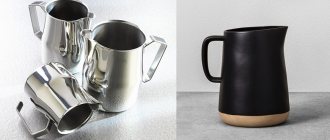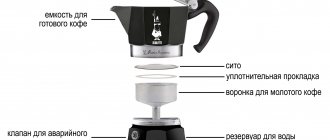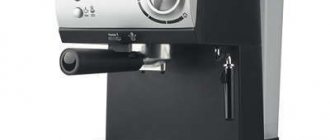Barista is an Italian word meaning a specialist in the preparation of espresso and coffee cocktails based on it (Americano, latte, cappuccino, etc.). The term is translated from Italian as “the person behind the counter,” but in the classical interpretation does not include waiters, salespeople, bartenders and other cafe (restaurant) workers. Technically, a barista is only responsible for coffee; his main responsibility is to operate the coffee machine, and other functions, such as serving customers at the table, selling baked goods, etc., are optional. However, this does not mean that the same employee cannot combine several “rates”, working simultaneously as a barista, a waiter and even a dishwasher.
Story
The barista profession is very young, she is not yet 30 years old. It is clear that someone brewed coffee in coffee shops before the 1980s, but it never occurred to anyone to single out this work as a separate type of career or even creativity, to learn the skill in special institutions. Usually the owner of the establishment or more experienced colleagues showed the newcomer how to operate the coffee machine, and that was where the education ended.
Today, baristas are respected people, they give interviews to reputable publications, participate in international competitions and, of course, some of them earn good money.
For this flourishing, we must thank large coffee chains like Starbucks - they turned the person behind the counter into an additional factor attracting customers. On the other hand, the requirements have also increased: a good barista must understand types of coffee, have a delicate sense of smell and taste, know everything or almost everything about the history of the drink and be able to prepare at least a dozen coffee cocktails.
Judging solely by Russian chain coffee shops, one might get the impression that barista is a predominantly male profession. In fact, inexorable statistics say the opposite: more than two thirds of all baristas in the world (68%) are girls, respectively, the stronger sex accounts for only 32%.
The average length of service in this position rarely exceeds 4 years; no more than 10% of baristas continue to develop their careers after 5 years or more.
Barista Basics
“Meet the barista” or “meet the barista”? 6 words that make us misspell cases
Do you think it is possible to wear a ninja costume? How about going to work as a barista? In this issue of “Literacy on the Mela” there is a new portion of words with which problems may arise when declension. Some of them don't bow at all!
Useful Mela newsletter twice a week: Tuesday and Friday
SUBSCRIBE
Right:
I prefer to ride in the back seat
Whatever seat in the car you choose, it would be better to be able to figure out the endings of nouns quickly. And this is the same knowledge from the school curriculum that we really use! Let’s remember a simple rule: neuter nouns ending in “-е” in the singular in the prepositional case have the ending “-e”: “in the back seat”, “on the coast”, “I’m in admiration”, “about happiness” and etc.
Right:
How to meet a barista?
Coffee shop workers are most often aware of the difficulties associated not only with the preparation and consumption of the drink itself, but also with the words denoting it. For example, about the stress in “latte”, double consonants in “cappuccino” (which are not there!) and, of course, the declension of the noun “barista”. And the secret is that it does not bend - since this is a relatively recent borrowing. So be careful: you can only meet a “barista”, you can’t catch a “barista” behind the counter, and you can also only ask a “barista”.
Right:
Feel like a ninja
Another borrowed word that is not inclined in Russian: “dress up as a ninja”, “feel like a ninja”, “take a photo with a ninja”. Translated from Japanese, “ninja” means “hiding, one who hides” - this is the name given to scouts and spies who master the martial art of ninjutsu. We can’t help but remember the magnificent four turtles who fight evil: perhaps the Ninja Turtles will help you remember that a word can have only one form.
Right:
Focus on product quality
Right:
Focus on product quality
There are entire constructions in the Russian language in which it is very easy to make a mistake in case. For example, we have already told you why you can’t “review a new film” and feel a “thirst for fame.”
Here is another such combination: is the emphasis placed on something or something? Here the dictionaries are more loyal than in previous cases: you can focus on “quality,” but the option with the prepositional case is more often used: “emphasis on quality.” The same thing works with the combination “place emphasis”: you can put emphasis “on studying cases”, or you can “on studying”.
Right:
Lay the foundation for the future theater
To ensure that great (and not so great) plans remain just plans, we advise you to be more careful with them. Yes, some people really believe that it is possible to “start changes” or “start the future of theatre.” Remember: you can only start with “something”, not “something”. Here, for example, from Chekhov: “He laid the foundation for a local ‘musical and dramatic circle’ and himself took part in performances” (“Literature Teacher”). In general, we use the dative case and pave the way for changes, changes, theaters and everything else that the soul desires.
Right:
Everything is the same at my alma mater
You can immediately add another noun to the list of indeclinables - your alma mater will definitely appreciate it! Today, this is the name given to the educational institution in which a person received his education, most often when they remember the place with gratitude and warmth. Translated from Latin, alma mater literally means “nursing mother.” Please note: in Russian the noun is used in the feminine gender and with a hyphen: “my alma mater.”
Cover image: Shutterstock / Greenbox
How much do baristas earn?
In the USA, the hourly wage of a barista ranges from 8 to 12.5 dollars, plus tips, respectively, these specialists earn 17-29 thousand per year. The work contract may also include bonuses, private health insurance, various bonuses and incentives. For working odd hours or overtime, the barista receives double the rate, which is about $20 per hour.
In Argentina, the minimum salary for a barista is $482 per month, with tips and bonuses almost tripling this amount ($1,222). In France, the salary level is almost no different from the American one, in Romania it is slightly lower: a beginner is unlikely to receive more than $420 a month, an experienced specialist should not expect more than $965.
In Ukraine, baristas earn on average about $240 per month (in Kyiv and several other large cities), in Russia this amount is almost twice as much ($443.61). Of course, “promoted” stars can receive thousands of dollars a month, but this is more than an exception to the rule.
What prospects do baristas have?
At first, coffee makers improve their skills, knowledge and abilities, gain experience in order to earn more. You can rise to the position of chef barista, as well as participate in various competitions and competitions.
But this is the only opportunity to grow as a barista. Then some move on to other positions, others, having gained experience, open their own coffee shops, and still others change their field of activity.
In Russia, a profession is considered a temporary part-time job while studying at the institute, for example. In the West, on the contrary, baristas become baristas after 30 years of age, when they realize that they like this business.
Differences between a bartender and a barista
| Barista | Bartender | |
| Field of activity | Coffee and everything connected with it: production methods (coffee machine, French press, aero press, etc.), types of coffee, origin, taste, methods of roasting beans, methods of serving and decoration (latte art and etc.). | Alcoholic drinks, mainly cocktails. |
| Knowledge level | Ideally, a deep, good barista should be almost a coffee historian, maintain contact with coffee brands, and know the kitchen “from the inside.” | Superficial - the bartender must be a practitioner and be able to mix liquids, and not a theorist. |
| Degree of independence | Relatively high: a significant portion of barista events do not have sponsors and do not pursue marketing benefits. | Relatively low, bartenders often promote a certain alcohol brand, earning additional money from this. |
| Ingredient Units | Grams and milliliters. | Ounces and parts. |
| Beverage temperature | Mostly high (with rare exceptions like ice cappuccino, etc.). | Mostly low (except for cocktails that are set on fire before serving). |
What does it take to become a barista?
To become a barista, you can take courses that last 10-30 hours. Price - 500-1000 rubles per hour of classes. They will show you how to make coffee and charge you 10-20 thousand rubles. During the course you will be able to form a general impression of the profession.
Interesting materials:
How much does the Twelfth Armature weigh? How much does Addison Rae weigh? How much does Yulia Gavrilina weigh 2022? How much does a truck wheel weigh? How much does a cube of pine board weigh? How much does a cube of a raw Christmas tree weigh? How much does a 6mm OSB sheet weigh? How much does a well hatch weigh? How much does one chocolate bar weigh? How much does one chicken heart weigh?
Pros and cons of being a barista
Advantages of being a barista:
- for coffee fans - an opportunity to work and develop in their favorite field;
- creative self-realization (professional baristas invent coffee cocktails themselves, try various combinations of coffee varieties);
- new acquaintances, strong “shop solidarity”, some of the regular customers can become real friends;
- flexible schedule, the ability to combine work and study;
- no threat of unemployment - coffee is drunk everywhere, good baristas are valued and will never be left without income;
- free unlimited coffee!
Disadvantages of being a barista:
- relatively low salary;
- working with people, often in conditions of stress, haste, pressure or dissatisfaction from clients;
- predominantly work for young people, rarely regarded as a long-term career;
- the working day can be long and tiring: the barista works “on his feet” and at the same time must not be scalded by boiling water, not drop or break anything, be smiling and cheerful, and create a light atmosphere in the coffee shop;
- professional deformation - coffee in other coffee shops, brewed by someone else, will most often seem tasteless and “wrong”;
- sometimes - depending on the coffee shop - irregular hours, work on night shifts, weekends.
What does a barista use when working?
The qualifications of a specialist largely depend on what tools he knows how to use. The responsibilities of a barista include grinding beans, brewing coffee, frothing milk, and decorating the finished drink. Each action requires special mechanisms, equipment, and accessories.
In addition to the basic equipment, a professional coffee maker must have scales, a thermometer, towels, rags, a shaker, a timer, and a knock box.
Coffee machine
Modern coffee machines can fully automate the process. Starting from grinding grains to serving whipped and heated milk. Nevertheless, real professionals more often choose levered (classic manual) varieties. The coffee maker manually controls the spillage, as a result, from the same raw materials he can prepare drinks with different taste, intensity, and aroma. It’s rare to see such a miracle in a modern coffee shop, and they cost about 400 thousand rubles.
The flow can be adjusted in a semi-automatic coffee machine. Only there is no lever (lever), the barista uses a button. This technique is considered a classic for an Italian coffee shop. It is used, like the previous option, in places that are not very accessible, since it requires the attention of the employee. Price 120-850 thousand rubles.
In places where there is high customer traffic and novice baristas work, automatic coffee machines are suitable. The boss sets up the device every day, and employees calmly brew coffee on it during their shift. The price depends on the manufacturer - 140-770 thousand rubles.
There are also superautomatic coffee machines. The barista simply needs to pour in the grain and milk, then the device itself will prepare the coffee depending on the program. The preparation of the drink is primitive, a coffee maker is not required, and visitors understand that in this establishment coffee is a related product, not the main one. The cost of equipment is 480-700 thousand rubles.
Coffee grinder
Professionals rarely use a regular kitchen coffee grinder. But sometimes this device can be found in inexpensive coffee shops. For this reason, the barista must be able to use the grinder so that the grind is uniform and the right size.
Grinder
This is a professional coffee grinder. It can be manual or automatic. A professional will need a grinder with the ability to adjust the grind size and uniformity of the mixture.
Holder
This is a portafilter, part of a coffee maker. Ground coffee is poured into it and pressed with tempera. Can be intended for preparing 1, 2 or 3 servings of drink.
Temper
Used for pressing coffee in a holder. It comes in different diameters, as well as handle shapes and sizes. The base is flat or convex. The specific type of tempera is selected to match the existing holder.
Pitcher
Stainless steel jug designed for frothing milk. When working as a barista, you may need pitchers of different volumes - 0.15, 0.35, 0.6, 1 l and others.
Jigger
Stainless steel measuring cups. Designed for preparing and measuring espresso used for lattes and other milk variations of coffee.
Demitas
Cup capacity 80 or 150-220 ml for espresso and cappuccino. Most often white.
Differences between professions in Russia and abroad
Table. What are the differences between working as a coffee maker in the Russian Federation and other countries?
| Options | Russia | Europe and America |
| Attitude to the profession | Temporary work | Life's work, profession to my liking |
| Earnings | Average | High |
| Responsibilities | Making coffee, brewing tea, sometimes making sandwiches | Wider range of responsibilities including room cleaning |
| Who works more often | Women | Men |










